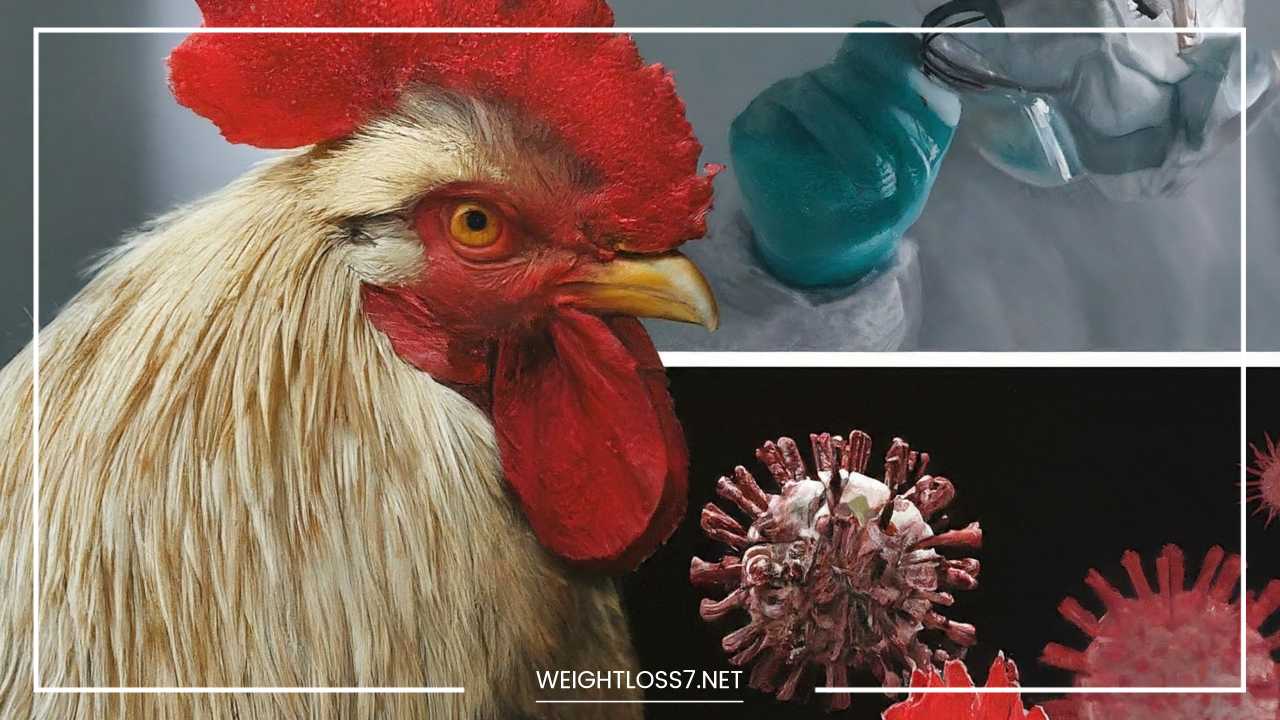Bird Flu: What You Need to Know to Stay Safe

Bird Flu
Bird Flu: A Comprehensive Guide to Understanding the Threat and Safeguarding Our Poultry
Bird flu, also known as avian influenza, is a highly contagious respiratory illness that poses a significant threat to poultry populations and public health.
This blog post delves into the complexities of bird flu, exploring its various strains, transmission methods, prevention strategies, and the potential impact on humans.
By understanding the science behind bird flu, we can take proactive measures to protect our flocks and ensure global food security.
Avian Influenza: A Spectrum of Severity
Bird flu viruses belong to the Orthomyxoviridae family and are categorized based on two surface proteins: hemagglutinin (H) and neuraminidase (N).
There are 18 different H types and 11 N types, resulting in 198 possible combinations. However, not all combinations cause illness in birds. The severity of bird flu ranges from mild to devastating, depending on the specific viral strain.
-
Low Pathogenic Avian Influenza (LPAI): LPAI strains are generally mild and cause few or no symptoms in infected birds. These birds may appear lethargic or have a slight decrease in egg production, but mortality rates are very low. LPAI strains can sometimes mutate into more virulent HPAI strains, highlighting the importance of continuous surveillance.
-
Highly Pathogenic Avian Influenza (HPAI): HPAI strains are highly contagious and cause severe illness and death in birds. Infected birds exhibit a range of symptoms, including:
- Respiratory distress (difficulty breathing, gasping)
- Facial and leg swelling
- Purple discoloration of the legs and wattle (fleshy area above the beak)
- Diarrhea
- Sudden death
Mortality rates from HPAI can approach 100% within 48 hours, causing devastating losses to poultry farms. The H5N1 and H7N9 strains are notorious examples of HPAI viruses that have caused significant outbreaks in recent years.
Transmission of Bird Flu: A Multifaceted Approach
Bird flu viruses are adept at spreading through various means, posing a challenge for biosecurity measures. Here’s a breakdown of the primary transmission routes:
-
Direct Contact: Infected birds can directly transmit the virus to healthy birds through close contact. This can occur through sharing contaminated feed, water, nesting materials, or even during aggressive pecking behavior.
-
Environmental Contamination: The virus can survive in feces, saliva, and feathers for weeks in the environment, particularly in cool, moist conditions. This contaminated material can then infect healthy birds that come into contact with it.
-
Wild Birds: Wild birds, particularly migratory waterfowl, can act as asymptomatic carriers of the virus. They can introduce the virus into new areas by contaminating bodies of water or feces coming into contact with domestic poultry. Due to their migratory nature, wild birds pose a significant challenge for controlling the spread of bird flu.
-
Humans (Zoonotic Transmission): While rare, bird flu can jump species and infect humans who have close contact with infected birds or contaminated environments. This typically occurs in people working in poultry farms, live bird markets, or those handling birds for hunting or recreational purposes.
The Global Threat of Bird Flu: Economic and Social Concerns
Bird flu outbreaks can have a devastating impact on the global food chain. Infected flocks are often culled to prevent further spread, leading to substantial economic losses for poultry farmers.
Additionally, outbreaks can disrupt poultry product exports, impacting food security in certain regions.
The economic impact extends beyond poultry farms, affecting related industries such as feed production, transportation, and retail.
Beyond the economic impact, bird flu outbreaks can also have significant social consequences. Large-scale culling of poultry can lead to shortages of eggs and chicken meat, impacting consumer prices and dietary habits.
In some regions, poultry plays a vital role in cultural practices and livelihoods, and outbreaks can disrupt these traditions.
Protecting Your Poultry from Bird Flu: A Multi-pronged Approach
Biosecurity is the cornerstone of preventing bird flu outbreaks in poultry farms. By implementing strict biosecurity measures, farmers can significantly reduce the risk of introducing the virus into their flocks. Here are some essential practices to adopt:
-
Vaccination: Regularly vaccinate your poultry against common LPAI strains. Vaccination can reduce the severity of illness, prevent mutations into HPAI strains, and minimize overall losses. It’s crucial to consult with a veterinarian to choose the appropriate vaccine for your region and bird species.
-
Quarantine Procedures: Implement a quarantine program for new birds introduced to the flock. Isolate them for a designated period (typically 30 days) and monitor for signs of illness before integrating them with the main flock. This practice helps prevent the introduction of new pathogens into the established population.
-
Biosecurity Measures: Maintain strict biosecurity measures to prevent the introduction of the virus from outside sources. This includes:
- Controlling access to the farm: Limit entry to authorized personnel only. Implement a sign-in system for visitors and require them to wear disposable protective clothing (coveralls, boots) before entering the poultry houses.
-
Footbaths: Install disinfectant footbaths at entrances and exits of poultry houses. Personnel should disinfect their footwear before entering and leaving the area.
-
Disinfection: Regularly disinfect poultry houses, equipment, and vehicles entering and leaving the farm. This helps to inactivate any potential virus particles present.
-
Rodent and Pest Control: Implement a rodent and pest control program to minimize the risk of these animals introducing the virus into poultry houses. Rodents can carry the virus on their fur and contaminate feed or water sources.
-
Proper Disposal: Dispose of dead birds promptly and hygienically to prevent further contamination. Composting or incineration are recommended methods, following local regulations.
-
Maintain Hygiene: Keep poultry houses clean and dry. Regularly remove manure and debris to reduce the risk of virus survival in the environment. Proper ventilation is also crucial to maintain good air quality and minimize respiratory issues in birds.
-
Monitor Bird Health: Regularly monitor your birds for signs of illness. Early detection is essential for containing outbreaks and minimizing losses. Be vigilant for symptoms such as:
- Respiratory distress (difficulty breathing, gasping)
- Lethargy or unusual behavior
- Decreased egg production
- Swelling of the face or legs
- Discoloration of the legs or wattle
- Diarrhea
If you suspect bird flu in your flock, immediately contact your local veterinarian or animal health authorities. Early intervention can prevent the spread of the virus and minimize economic losses.
The Human-Animal Interface: Bird Flu and Public Health
While the risk of bird flu transmission to humans is low, it’s not nonexistent. People who work closely with poultry, such as farmers, veterinarians, and live bird market workers, are at higher risk.
Public health measures focus on minimizing the risk of human exposure and ensuring preparedness in case of outbreaks.
-
Surveillance: Implementing robust surveillance programs in poultry farms is crucial for early detection of outbreaks. Regular testing of birds can help identify infected flocks before the virus spreads further.
-
Biosecurity: Encouraging and enforcing biosecurity measures in poultry farms is critical to minimize the risk of human exposure to the virus. This protects not only the birds but also the health of farm workers and the public.
-
Personal Protective Equipment (PPE): Poultry workers should wear appropriate PPE, such as masks, gloves, and boots, when handling birds or cleaning poultry houses. This minimizes the risk of contact with infected birds or contaminated materials.
-
Public Awareness: Educating the public about bird flu, its symptoms, and how to avoid contact with infected birds is essential. Public health agencies should provide clear information on safe handling practices for poultry products and avoiding contact with sick or dead wild birds.
-
Antiviral Medications: Stockpiling antiviral medications can be crucial in the event of a human outbreak. These medications can help reduce the severity of illness and prevent further transmission. International collaboration and resource sharing are vital for ensuring equitable access to these medications in case of a pandemic.
International Cooperation: A United Front Against Bird Flu
Bird flu is a global threat that requires international cooperation for effective prevention and control. Here are some key aspects of international collaboration:
-
Information Sharing: Sharing information about outbreaks, virus strains, and control measures is crucial for a coordinated global response. International organizations like the World Organisation for Animal Health (OIE) play a vital role in facilitating this information exchange.
-
Research and Development: Continued research and development of vaccines and antiviral medications are essential for combating bird flu. International collaboration can accelerate these efforts and ensure access to these resources for countries with limited resources.
-
Travel Restrictions: In severe outbreaks, temporary travel restrictions on poultry products and live birds may be necessary to prevent the spread of the virus. However, such measures should be implemented in a coordinated manner to minimize disruptions to global trade.
-
Emergency Response Planning: Developing and implementing international emergency response plans is crucial for a rapid and effective response to large-scale outbreaks. This includes stockpiling essential resources, deploying response teams, and providing technical assistance to affected countries.
By working together, the international community can develop a more robust defense against bird flu, safeguarding animal and human health and ensuring global food security.
Final Word: A Proactive Approach to Bird Flu
Bird flu is a complex and ever-evolving threat. By understanding the science behind the virus, implementing biosecurity measures, and promoting international cooperation, we can effectively manage this threat.
A proactive approach that combines prevention, surveillance, and preparedness is critical for protecting our poultry flocks, public health, and global food security.
Looking Forward: New Technologies and Sustainable Solutions
Research and development continue to play a vital role in the fight against bird flu. Here are some promising areas of exploration:
- Next-Generation Vaccines: Developing more effective and broadly protective vaccines that can combat a wider range of bird flu strains.
- Viral Diagnostics: Developing faster and more accurate diagnostic tests for identifying bird flu infections at earlier stages.
- Biosecurity Innovations: Exploring technologies like air filtration systems, automated disinfection protocols, and novel biosecurity materials to further enhance farm safety.
- Sustainable Poultry Practices: Promoting sustainable poultry farming practices that minimize stress on birds, improve immune function, and potentially reduce susceptibility to bird flu.
The Importance of Responsible Poultry Consumption
Consumer choices can also play a role in mitigating the risk of bird flu outbreaks. Here are some ways consumers can be responsible:
- Supporting Local Farmers: Purchase poultry products from local farmers who implement strict biosecurity measures.
- Safe Handling Practices: Always follow safe handling practices when preparing poultry products, such as proper cooking temperatures and avoiding cross-contamination.
- Responsible Disposal: Dispose of poultry carcasses and waste properly to prevent attracting wild birds that may carry the virus.
By working together, from farmers and veterinarians to public health officials and consumers, we can create a more robust defense against bird flu.
With proactive measures, scientific advancements, and responsible practices, we can ensure the health of our poultry flocks, safeguard public health, and maintain a stable global food supply.

















